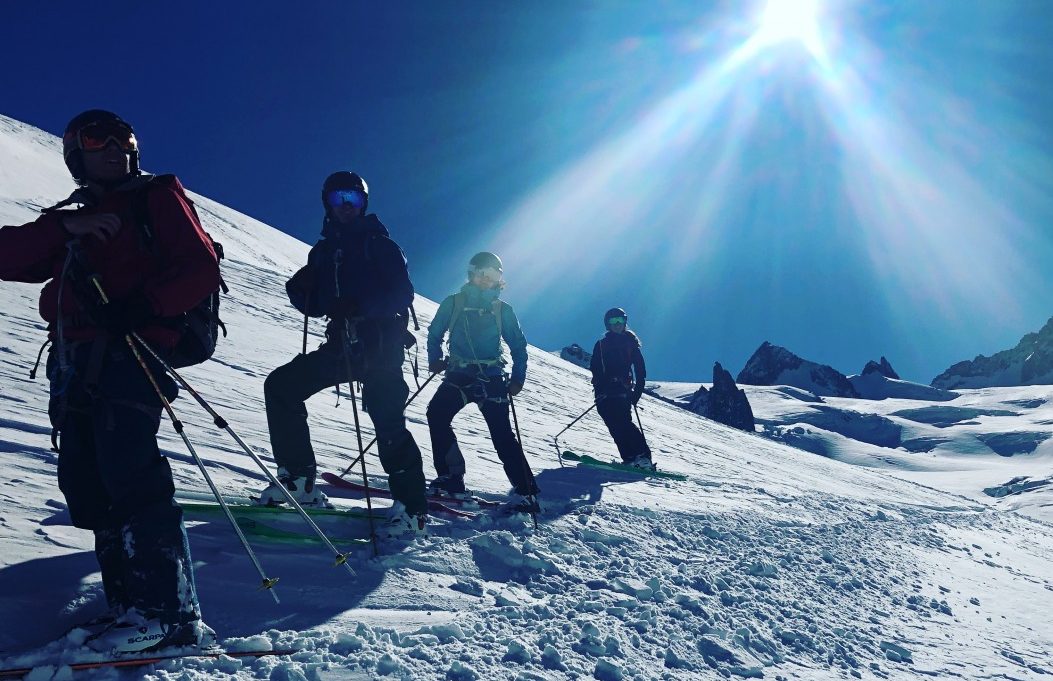In the backcountry, who you choose to ski with is often as important as the terrain you choose to ski. In this next excerpt from Rob Coppolillo’s Ski Guide Manual, he digs into the psychology behind mistake making in the backcountry and ways to foster positive group dynamics. Want more? Pre-order the Ski Guide Manual.
I keep mentioning “functioning” teams and warning about “breakdowns.” Let’s really consider what kind of team we want. I’d argue that we need more than buddies “who have my back.” Sure, that’s part of it, but you also need a diverse gang, people willing to disagree respectfully, communicate effectively, commit to learning, and agree on a collaborative process. Guiding, climbing with friends, even just a road trip to go skiing — if we can’t agree on the “how” of the activity, there’s little hope of putting together a resilient, capable team, no matter what we’re doing.
Talk early, talk lots
Sexton and Helmreich, writing in the Journal of Human Performance in Extreme Environments, state, “NASA researchers analyzed the causes of jet transport accidents and incidents between 1968 and 1976 . . . and concluded that pilot error was more likely to reflect failures in team communication and coordination than deficiencies in technical proficiency.”
Just like Dekker warns us that “human error” is usually more indicative of an error of process, NASA’s research reveals that breakdowns in communication are often mistaken as mere pilot error rather than a problem in team, communication, and/or process.
The Sexton-Helmreich paper goes on to explain, “Crew performance was more closely associated with the quality of crew communication than with the technical proficiency of individual pilots. . . . No differences were found between the severity of the errors made by effective and ineffective crews; rather, it was the ability of the effective crews to communicate that kept their errors from snowballing into undesirable outcomes.”
All teams make mistakes, whether in the backcountry or outer space, but it’s the high-functioning team that catches the mistake, error corrects, and stays safer. Remember, though, error correction requires the humility to admit an error in the first place.
Their paper goes on to harvest insight from bunches more research, including decades-long NASA findings, but they stress that successful crews tended to communicate more and earlier than lower-performing crews. That is, teammates discussed the mission, what was expected, how they’d go about it, and identified problems before and during their work.
In researching the topic of teamwork, these themes of effective communication resurfaced time and time again. I highlight here the Sexton- Helmreich paper because it so expertly explains that a strong team trumps individual talents, and concludes, “Such findings are not unique to aviation, as similar results have emerged in other safety-critical systems.”
Turn taking and psychological safety
In decision making and debriefing, collaborative and respectful communication helps facilitate our process. Obviously these characteristics should infuse our teamwork too. Easier said than done, especially when we’re sometimes operating in a stressful environment.
In 2012 tech giant Google, in its “Project Aristotle,” investigated why some of its teams outperform others. Studying 180 teams across its empire, at first researchers were stumped as to why some of them excelled while others faltered. High-performing teams seemingly behaved differently; what derailed some teams became a strength in others, and so on.
After months of confounding observations, the Google researchers at last identified two shared characteristics among all of their successful teams. First, teammates generally spoke equally among themselves. The teams had “equality in distribution of conversational turn-taking.” In short, everybody spoke about the same amount over the course of a project. Team members didn’t necessarily speak equally on every task, but over a given project, “As long as everyone got a chance to talk, the team did well,” reported the New York Times.
Second, the better teams all shared a culture of “psychological safety,” defined by Harvard professor Dr. Amy Edmonson as “a sense of confidence that the team will not embarrass, reject or punish someone for speaking up.”
Edmonson began her career researching hospital units. She assumed that “better” teams would make fewer mistakes, but what she found shattered her view. Higher-performing teams were making more mistakes. She dug deeper. In fact, the better teams were openly acknowledging their mistakes and addressing them in a collaborative, productive way. Mistakes weren’t hidden or deemphasized; they were highlighted and dissected, with an eye toward learning and prevention.
So the openness was there, and it led to better outcomes, and based on her work, it had to do with a sense of safety among teammates. She cautions, though, not to interpret this as a fuzzy, touchy-feely sentiment. Interviewed on Harvard Business Review’s “Ideacast” podcast, she explains: “What it’s about is candor; what it’s about is being direct, taking risks, being willing to say, ‘I screwed that up.’ Being willing to ask for help when you’re in over your head.”
This naturally circles back to our debrief, near misses, and respectful team communication. To get there, we need to continuously create and foster a sense of this psychological safety among teammates. It is not something we do in the fall and then let it grow stale throughout winter. It requires ongoing attention, in guide meetings and trip plans with buddies.
Edmonson stresses the importance: “And so I always want to explain, there is an observed and quite robust correlation between psychological safety and learning and performance.”
A high-performing team commits to excellence, improvement, and learning from its inevitable mistakes— and all this comes more easily in a supportive, safe team environment. And ask yourself, What are the consequences of riding with a low-performing team?
Rob Coppolillo is a mountain guide and writer, based on Vashon Island, in Puget Sound. He’s the author of The Ski Guide Manual.

